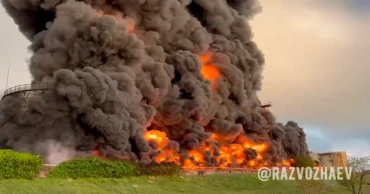drone
Govt approves drone shows, ‘July Revival Programmes’
The government on Tuesday approved two separate proposals from the Ministry of Cultural Affairs to commemorate the historic July uprising though various events.
The approval came at a meeting of Advisers Council Committee on Economic Affairs held at the Bangladesh Secretariat with Finance Adviser Dr Salehuddin Ahmed in the chair.
As part of the programmes, the committee approved a proposal under the Direct Procurement Method (DPM) in the goods and services category for renting drones and conducting drone exhibitions through local and Chinese firms.
The drone shows will be organised in five locations to commemorate the historic July events.
Another proposal under the DPM method was also approved in principle to implement various components of the “July Revival Programmes” on an urgent basis.
Political parties betrayed people after July Uprising: Nahid
These include documentary exhibitions through LED displays inspired by the July Uprising in 63 districts and Dhaka, wreath-laying at July memorials, rallies, memorial events, and printing of posters, event designs, and invitation cards.
It also gave approval in principle to a proposal for selling around 3.45 acres of land belonging to Latif Bawany Jute Mills Limited at Hajipur Mouja under Narsingdi Sadar upazila.
Latif Bawany Jute Mills, established in 1953, has been operating under the Bangladesh Jute Mills Corporation (BJMC) since 1972. The mill currently holds a total of 83.45 acres of land.
5 months ago
Ukraine strikes Russian airbase as drone attacks intensify
Ukraine on Saturday said it struck a Russian airbase as Russia launched hundreds of drones overnight in its latest wave of long-range attacks, further diminishing hopes of progress toward ending the war that has now dragged on for over three years.
Ukraine’s military General Staff confirmed that its forces targeted the Borisoglebsk airbase in Russia’s Voronezh region, which it described as the “home base” for Russia’s Su-34, Su-35S, and Su-30SM fighter jets.
In a statement on Facebook, the General Staff said the strike hit a depot containing glide bombs, a training aircraft, and “possibly other aircraft.”
Russian officials have not yet commented on the reported attack.
Strikes on Russian airbases are part of Ukraine’s efforts to weaken Russia’s military capability and demonstrate its reach into high-value targets deep inside Russian territory. Last month, Ukraine claimed to have destroyed over 40 Russian aircraft stationed at various airfields inside Russia during a surprise drone operation.
Meanwhile, Ukraine’s air force reported that Russia launched 322 drones and decoys into Ukrainian territory overnight into Saturday. Of these, 157 were intercepted and destroyed, while 135 were lost, likely due to electronic jamming, according to Ukrainian officials.
The western Khmelnytskyi region was the main target of the latest attacks. However, regional Governor Serhii Tyurin said no damage, injuries, or fatalities were reported.
Ukraine pursues joint weapons production with allies as US pauses some arms shipments
Russia has recently escalated its long-range aerial bombardments on Ukraine. On Friday, waves of drones and missiles targeted Kyiv in what officials described as the largest aerial assault since the invasion began. The attack killed one person and injured at least 26 others.
The renewed Russian offensive follows Ukrainian President Volodymyr Zelenskyy’s phone conversation with US President Donald Trump on Friday. Zelenskyy described the discussion as “very important and productive,” saying the leaders talked about strengthening Ukraine’s air defenses, the potential for joint US-Ukraine weapons production, and broader U.S.-led initiatives to end the war.
Speaking to reporters Friday night, Trump confirmed the call, saying, “We had a very good call, I think.”
When asked about the prospects of ending the war, Trump responded, “I don’t know. I can’t tell you whether or not that’s going to happen.”
The US has recently paused shipments of certain military aid to Ukraine, including vital air defense missiles. European allies are now considering how they can fill the gap. Zelenskyy has said plans are underway to expand Ukraine’s domestic arms production, though scaling up such efforts will take time.
Russia’s Defense Ministry claimed it shot down 94 Ukrainian drones overnight, along with an additional 12 drones on Saturday morning. No casualties have been reported in connection with those incidents.
5 months ago
Pakistan shoots down Indian drone in the city of Lahore, officials say
Pakistan’s air defense forces shot down an Indian drone early Thursday in Lahore, according to government sources, amid escalating tensions with India. This comes as India evacuates thousands from villages near the volatile border in the disputed Kashmir region.
The drone incident occurred a day after Indian missile strikes on Pakistani territory reportedly killed 31 civilians, including women and children, according to Pakistani officials.
Relations between the two nations have sharply deteriorated since April 22, when an attack by armed gunmen in India-administered Kashmir left 26 people dead, most of them Indian Hindu tourists. India blamed Pakistan for supporting the militants behind the attack, a claim Islamabad has denied.
Police officer Mohammad Rizwan confirmed that a drone was shot down near Walton Airport, a civilian and military airfield located in a residential area of Lahore, approximately 25 kilometers (16 miles) from the Indian border.
Local media also reported that two more drones were brought down in other cities within Punjab province, where Lahore serves as the capital.
Iran’s Foreign Minister in Delhi amid India-Pakistan tensions
According to two unnamed security officials, the drone was a small Indian model intercepted by Pakistan’s air defense. They declined to be identified, citing restrictions on speaking to the press. It remains unclear whether the drone was carrying weapons.
The incident has not yet been independently verified, and Indian authorities have not issued an official response.
Meanwhile, in Punjab’s Chakwal district, another drone crashed into farmland. No injuries were reported. Police chief Ghulam Mohiuddin did not specify the drone’s origin, but said authorities have secured the wreckage and launched an investigation into its source and mission.
India said its strikes Wednesday targeted at least nine sites in Pakistan linked to planning terrorist attacks against India. Some of these targets were in Punjab and most of Wednesday's casualties were in this province.
Pakistani Prime Minister Shehbaz Sharif vowed overnight to avenge the killings but gave no details, raising fears of a broader conflict between the two nuclear-armed neighbors.
Across the de-facto border in Indian-controlled Kashmir, tens of thousands of people slept in shelters overnight, officials and residents said Thursday.
Indian authorities evacuated civilians from dozens of villages living close to the highly militarized Line of Control overnight while some living in border towns like Uri and Poonch left their homes voluntarily, three police and civil officials said. They spoke on condition of anonymity in keeping with departmental regulations.
7 months ago
Bangladesh to introduce drone technology to assess crop losses
Bangladesh is preparing to introduce remote sensing and drones to detect crop damage caused by extreme weather events or diseases, said the Asian Development Bank (ADB).
Around 20 officers of the Department of Agricultural Extension (DAE) are initially receiving training to learn how to use the state-of-the-art technologies.
Malay Choudhury, Additional Secretary, Ministry of Agriculture, and Edimon Ginting, ADB Country Director for Bangladesh inaugurated a workshop titled “The Use of Drone and Satellite Image for Crop Monitoring and Crop Damage Assessment” in Dhaka on Tuesday to initiate a seven-day training programme.
ADB forecasts Bangladesh's GDP growth at 6.1% in FY 2023-24, anticipates rise to 6.6% next year
DAE and ADB jointly designed the training programme that will continue till April 25 April, according to ADB.
Renowned geospatial experts from the International Crops Research Institute for the Semi-Arid Tropics (ICRISAT) will conduct the training.
The trainees will receive four days of classroom training on geographical information systems (GIS) and remote sensing analysis for crop damage detection and participate in a three-day field trip to Sylhet to learn how to collect ground data using mobile devices.
Local DAE officials are expected to participate in the training in Sylhet, where the 2022 floods caused major crop damage.
ADB to increase cooperation in Bangladesh climate actions: Environment Minister
Proper assessment of crop diseases and losses are critical to take appropriate measures to ensure agricultural productivity and food security in the context of growing threats of climate change in Bangladesh, said Country Director Edimon Ginting.
“ADB will continue to bring in innovative solutions including advanced technologies to help Bangladesh tackle climate impacts,” Ginting added.
With advanced geospatial technology, our officers will be able to assess crop damage and provide effective government programs to mitigate the expected damage caused by climate change in the future, said Badal Chandra Biswas, Director General, DAE.
PM Hasina seeks more support from ADB for socioeconomic uplift
Following the training program, ADB and DAE plan to produce joint reports on crop damage assessment in the Sylhet region, conduct a project evaluation study of an ADB-supported integrated water management project in Gopalganj areas, and implement a nationwide climate disaster assessment in a small local government unit.
Japan Fund for Prosperous and Resilient Asia and the Pacific financed by the Government of Japan provided the grant fund for the training program through the Asian Development Bank.
1 year ago
Drone taxis will be up and running between South Korea’s Incheon airport and Seoul in 2025: Mayor
Mayor of South Korea’s Incheon metropolitan city, Yoo Jeong-bok, has said drone taxis will be up and running between Incheon International Airport and the capital city Seoul in 2025.
“Incheon is considered one of the best places to do business and a great place to invest in (South) Korea by leading companies at home and abroad,” he said.
The mayor was addressing a farewell reception marking the conclusion of the World Journalists Conference 2023 in Incheon on April 28.
Read More: Known for laughs, DC dinner spotlights risks of journalism.
2 years ago
Drone causes fire at Crimea oil reservoir: Russian official
A massive fire erupted at an oil reservoir in Crimea after it was hit by a drone, a Russia-appointed official there reported Saturday.
Mikhail Razvozhayev, the Moscow-installed governor of the Black Sea peninsula's port city of Sevastopol, posted videos and photos of the blaze on his Telegram channel.
Razvozhayev said the fire was assigned the highest ranking in terms of how complicated it will be to extinguish.
He did not say whether the drone he cited as causing the fire was Ukrainian. Russia annexed Crimea from Ukraine in 2014, a move that most of the world considered illegal. Ukrainian President Volodymyr Zelenskyy has said his country is seeking to reclaim the peninsula during Russia's current full-scale invasion.
The incident comes a day after Russia fired more than 20 cruise missiles and two drones at Ukraine, killing at least 23 people. Almost all of the victims died when two missiles slammed into an apartment building. Three children were among the dead.
Razvozhayev said the oil reservoir fire did not cause any casualties and would not hinder fuel supplies in Sevastopol.
The city has been subject to regular attack attempts with drones, especially in recent weeks.
Earlier this week, Razvozhayev reported that the Russian military destroyed a Ukrainian sea drone that attempted to attack the harbor and another one blew up, shattering windows in several apartment buildings, but not inflicting any other damage.
Ukrainian officials did not immediately comment on the oil reservoir fire. After previous attacks on Crimea, Kyiv usually stopped short of openly claiming responsibility but emphasized that the country had the right to strike any target in response to Russian aggression.
2 years ago
Drone advances in Ukraine could bring dawn of killer robots
Drone advances in Ukraine have accelerated a long-anticipated technology trend that could soon bring the world’s first fully autonomous fighting robots to the battlefield, inaugurating a new age of warfare.
The longer the war lasts, the more likely it becomes that drones will be used to identify, select and attack targets without help from humans, according to military analysts, combatants and artificial intelligence researchers.
That would mark a revolution in military technology as profound as the introduction of the machine gun. Ukraine already has semi-autonomous attack drones and counter-drone weapons endowed with AI. Russia also claims to possess AI weaponry, though the claims are unproven. But there are no confirmed instances of a nation putting into combat robots that have killed entirely on their own.
Experts say it may be only a matter of time before either Russia or Ukraine, or both, deploy them.
“Many states are developing this technology,” said Zachary Kallenborn, a George Mason University weapons innovation analyst. ”Clearly, it’s not all that difficult.”
The sense of inevitability extends to activists, who have tried for years to ban killer drones but now believe they must settle for trying to restrict the weapons’ offensive use.
Ukraine’s digital transformation minister, Mykhailo Fedorov, agrees that fully autonomous killer drones are “a logical and inevitable next step” in weapons development. He said Ukraine has been doing “a lot of R&D in this direction.”
“I think that the potential for this is great in the next six months,” Fedorov told The Associated Press in a recent interview.
Ukrainian Lt. Col. Yaroslav Honchar, co-founder of the combat drone innovation nonprofit Aerorozvidka, said in a recent interview near the front that human war fighters simply cannot process information and make decisions as quickly as machines.
Ukrainian military leaders currently prohibit the use of fully independent lethal weapons, although that could change, he said.
“We have not crossed this line yet – and I say ‘yet’ because I don’t know what will happen in the future.” said Honchar, whose group has spearheaded drone innovation in Ukraine, converting cheap commercial drones into lethal weapons.
Russia could obtain autonomous AI from Iran or elsewhere. The long-range Shahed-136 exploding drones supplied by Iran have crippled Ukrainian power plants and terrorized civilians but are not especially smart. Iran has other drones in its evolving arsenal that it says feature AI.
Without a great deal of trouble, Ukraine could make its semi-autonomous weaponized drones fully independent in order to better survive battlefield jamming, their Western manufacturers say.
Those drones include the U.S.-made Switchblade 600 and the Polish Warmate, which both currently require a human to choose targets over a live video feed. AI finishes the job. The drones, technically known as “loitering munitions,” can hover for minutes over a target, awaiting a clean shot.
“The technology to achieve a fully autonomous mission with Switchblade pretty much exists today,” said Wahid Nawabi, CEO of AeroVironment, its maker. That will require a policy change — to remove the human from the decision-making loop — that he estimates is three years away.
Drones can already recognize targets such as armored vehicles using cataloged images. But there is disagreement over whether the technology is reliable enough to ensure that the machines don’t err and take the lives of noncombatants.
Read more: Ukraine reports more Russian drone attacks
The AP asked the defense ministries of Ukraine and Russia if they have used autonomous weapons offensively – and whether they would agree not to use them if the other side similarly agreed. Neither responded.
If either side were to go on the attack with full AI, it might not even be a first.
An inconclusive U.N. report last year suggested that killer robots debuted in Libya’s internecine conflict in 2020, when Turkish-made Kargu-2 drones in full-automatic mode killed an unspecified number of combatants.
A spokesman for STM, the manufacturer, said the report was based on “speculative, unverified” information and “should not be taken seriously.” He told the AP the Kargu-2 cannot attack a target until the operator tells it to do so.
Fully autonomous AI is already helping to defend Ukraine. Utah-based Fortem Technologies has supplied the Ukrainian military with drone-hunting systems that combine small radars and unmanned aerial vehicles, both powered by AI. The radars are designed to identify enemy drones, which the UAVs then disable by firing nets at them — all without human assistance.
The number of AI-endowed drones keeps growing. Israel has been exporting them for decades. Its radar-killing Harpy can hover over anti-aircraft radar for up to nine hours waiting for them to power up.
Other examples include Beijing’s Blowfish-3 unmanned weaponized helicopter. Russia has been working on a nuclear-tipped underwater AI drone called the Poseidon. The Dutch are currently testing a ground robot with a .50-caliber machine gun.
Honchar believes Russia, whose attacks on Ukrainian civilians have shown little regard for international law, would have used killer autonomous drones by now if the Kremlin had them.
“I don’t think they’d have any scruples,” agreed Adam Bartosiewicz, vice president of WB Group, which makes the Warmate.
AI is a priority for Russia. President Vladimir Putin said in 2017 that whoever dominates that technology will rule the world. In a Dec. 21 speech, he expressed confidence in the Russian arms industry’s ability to embed AI in war machines, stressing that “the most effective weapons systems are those that operate quickly and practically in an automatic mode.” Russian officials already claim their Lancet drone can operate with full autonomy.
“It’s not going to be easy to know if and when Russia crosses that line,” said Gregory C. Allen, former director of strategy and policy at the Pentagon’s Joint Artificial Intelligence Center.
Switching a drone from remote piloting to full autonomy might not be perceptible. To date, drones able to work in both modes have performed better when piloted by a human, Allen said.
The technology is not especially complicated, said University of California-Berkeley professor Stuart Russell, a top AI researcher. In the mid-2010s, colleagues he polled agreed that graduate students could, in a single term, produce an autonomous drone “capable of finding and killing an individual, let’s say, inside a building,” he said.
An effort to lay international ground rules for military drones has so far been fruitless. Nine years of informal United Nations talks in Geneva made little headway, with major powers including the United States and Russia opposing a ban. The last session, in December, ended with no new round scheduled.
Washington policymakers say they won’t agree to a ban because rivals developing drones cannot be trusted to use them ethically.
Toby Walsh, an Australian academic who, like Russell, campaigns against killer robots, hopes to achieve a consensus on some limits, including a ban on systems that use facial recognition and other data to identify or attack individuals or categories of people.
“If we are not careful, they are going to proliferate much more easily than nuclear weapons,” said Walsh, author of “Machines Behaving Badly.” “If you can get a robot to kill one person, you can get it to kill a thousand.”
Scientists also worry about AI weapons being repurposed by terrorists. In one feared scenario, the U.S. military spends hundreds of millions writing code to power killer drones. Then it gets stolen and copied, effectively giving terrorists the same weapon.
Read more: Russia, shaken by Ukrainian strike, could step up drone use
The global public is concerned. An Ipsos survey done for Human Rights Watch in 2019 found that 61% of adults across 26 countries oppose the use of lethal autonomous weapons systems.
To date, the Pentagon has neither clearly defined “autonomous weapon” nor authorized a single such weapon for use by U.S. troops, said Allen, the former Defense Department official. Any proposed system must be approved by the chairman of the Joint Chiefs of Staff and two undersecretaries.
That’s not stopping the weapons from being developed across the U.S. Projects are underway at the Defense Advanced Research Projects Agency, military labs, academic institutions and in the private secto
The Pentagon has emphasized using AI to augment human warriors. The Air Force is studying ways to pair pilots with drone wingmen. A booster of the idea, former Deputy Defense Secretary Robert O. Work, said in a report last month that it “would be crazy not to go to an autonomous system” once AI-enabled systems outperform humans — a threshold that he said was crossed in 2015, when computer vision eclipsed that of humans.
Humans have already been pushed out in some defensive systems. Israel’s Iron Dome missile shield is authorized to open fire automatically, although it is said to be monitored by a person who can intervene if the system goes after the wrong target.
Multiple countries, and every branch of the U.S. military, are developing drones that can attack in deadly synchronized swarms, according to Kallenborn, the George Mason researcher.
So will future wars become a fight to the last drone?
That’s what Putin predicted in a 2017 televised chat with engineering students: “When one party’s drones are destroyed by drones of another, it will have no other choice but to surrender.”
2 years ago
Russia, shaken by Ukrainian strike, could step up drone use
Emergency crews on Tuesday sifted through the rubble of a building struck by Ukrainian rockets, killing at least 63 Russian soldiers in the latest blow to the Kremlin’s war strategy as Ukraine says Moscow’s tactics could be shifting.
An Associated Press video of the scene in Makiivka, a town in the partially Russian-occupied eastern Donetsk region, showed five cranes and emergency workers removing big chunks of concrete under a clear blue sky.
In the attack, which apparently happened last weekend, Ukrainian forces fired rockets from a U.S.-provided HIMARS multiple launch system, according to a Russian Defense Ministry statement.
Read more: Ukrainian rocket strike kills 63 Russian troops: Moscow
It was one of the deadliest attacks on the Kremlin’s forces since the war began more than 10 months ago and an embarrassment that stirred renewed criticism inside Russia of the way the war is being conducted.
The Russian statement Monday about the attack provided few other details. Other, unconfirmed reports put the death toll much higher.
The Strategic Communications Directorate of Ukraine’s armed forces claimed Sunday that around 400 mobilized Russian soldiers were killed in a vocational school building in Makiivka and about 300 more were wounded. That claim couldn’t be independently verified. The Russian statement said the strike occurred “in the area of Makiivka” and didn’t mention the vocational school.
Satellite photos analyzed by The AP show the apparent aftermath of the strike. An image from Dec. 20 showed the building standing. An image from Jan. 2 showed it reduced to rubble. Other days had intense cloud cover, making seeing the site by standard satellite imagery impossible.
Vigils for soldiers killed in the strike took place in two Russian cities Tuesday, the state RIA Novosti agency reported.
In Samara, in southwestern Russia, locals gathered for an Orthodox service in memory of the dead. The service was followed by a minute’s silence, and flowers were laid at a Soviet-era war memorial, RIA reported.
Unconfirmed reports in Russian-language media said the victims were mobilized reservists from the region.
With the fighting raging much longer than anticipated by the Kremlin, and becoming bogged down in a war of attrition amid a Ukrainian counteroffensive backed by Western-supplied weapon s, Russian President Vladimir Putin is mulling ways of regaining momentum.
His plan, according to Ukrainian officials, includes stepping up bombardments of Ukraine territory with Iranian-made exploding drones.
“We have information that Russia is planning a prolonged attack by Shaheds (exploding drones),” Ukrainian President Volodymyr Zelenskyy said in his nightly video address late Monday.
He said the goal is to break Ukraine’s resistance by “exhausting our people, (our) air defense, our energy,” more than 10 months after Russia invaded its neighbor.
For the Russian military, the exploding drones are a cheap weapon which also spreads fear among Ukrainian troops and civilians. The United States and its allies have sparred with Iran over Tehran’s role in allegedly supplying Moscow with the drones.
The Institute for the Study of War said that Putin is striving to strengthen support for his strategy among key voices in Russia.
“Russia’s air and missile campaign against Ukraine is likely not generating the Kremlin’s desired information effects among Russia’s nationalists,” the think tank said late Monday.
Read more: Ukraine reports more Russian drone attacks
“Such profound military failures will continue to complicate Putin’s efforts to appease the Russian pro-war community and retain the dominant narrative in the domestic information space,” it added.
Putin’s additional reliance on drones might not help him achieve his goals, however, as Ukraine claims a high success rate against the weapons.
During the first two days of the new year, which were marked by relentless nighttime drone attacks on Ukrainian cities and energy infrastructure, the country’s forces shot down more than 80 Iranian-made drones, Zelenskyy said.
Since September, Ukraine’s armed forces have shot down almost 500 drones, Ukrainian air force spokesman Yurii Ihnat claimed in a television interview Tuesday.
As well as seeking to wear down resistance to Russia’s invasion, the long-range bombardments have targeted the power grid to leave civilians at the mercy of biting winter weather as power outages ripple across the country.
In the latest fighting, a Russian missile strike overnight on the city of Druzhkivka in the Donetsk region wounded two people, the deputy head of Ukraine’s presidential office, Kyrylo Tymoshenko, reported Tuesday.
The Russian military on Tuesday acknowledged carrying out strikes on Druzhkivka and Kramatorsk, also in Donetsk. The Defense Ministry claimed it destroyed four HIMARS launchers in the area. This claim could not be independently verified.
A reporter with French broadcaster TF1 was live on television screens when a blast from one of the strikes erupted behind him in Druzhkivka. A German reporter with Bild newspaper suffered a minor injury from shrapnel in the same bombardment.
Officials said the attack ruined an ice hockey arena described as the largest hockey and figure skating school in Ukraine.
In the recently retaken areas of the southern Kherson region, Russian shelling on Monday killed two people and wounded nine, Kherson’s Ukrainian governor, Yaroslav Yanushevych, said Tuesday. He said Russian forces fired at the city of Kherson 32 times on Monday.
He also reported that two people were killed in the Kherson region Tuesday after driving over a mine left by withdrawing Russian troops.
Also, one civilian was killed and two others wounded on Tuesday morning as Russian forces shelled the city of Kurakhove in the eastern Donetsk region, hitting a residential area, local Gov. Pavlo Kyrylenko reported.
2 years ago
Minister: Ukraine aims to develop air-to-air combat drones
Ukraine has bought some 1,400 drones, mostly for reconnaissance, and plans to develop combat models that can attack the exploding drones Russia has used during its invasion of the country, according to the Ukrainian government minister in charge of technology.
In a recent interview with The Associated Press, Minister of Digital Transformation Mykhailo Fedorov described Russia’s war in Ukraine as the first major war of the internet age. He credited drones and satellite internet systems like Elon Musk’s Starlink with having transformed the conflict.
Ukraine has purchased drones like the Fly Eye, a small unmanned aerial vehicle used for intelligence, battlefield surveillance and reconnaissance.
“And the next stage, now that we are more or less equipped with reconnaissance drones, is strike drones,” Federov said. “These are both exploding drones and drones that fly up to three to 10 kilometers and hit targets.”
He predicted “more missions with strike drones” in the future, but would not elaborate. “We are talking there about drones, UAVs, UAVs that we are developing in Ukraine. Well, anyway, it will be the next step in the development of technologies,” he said.
Russian authorities have alleged several Ukrainian drone strikes on its military bases in recent weeks, including one on Monday in which they said Russian forces shot down a drone approaching the Engels airbase located more than 600 kilometers (over 370 miles) from the Ukrainian border.
Russia’s military said debris killed three service members but no aircraft were damaged. The base houses Tu-95 and Tu-160 nuclear-capable strategic bombers that have been involved in launching strikes on Ukraine.
Ukrainian authorities have never formally acknowledged carrying out such drone strikes, but they have made cryptic allusions to how Russia might expect retaliation for its war in Ukraine, including within Russian territory.
Ukraine is carrying out research and development on drones that could fight and down other drones, Federov said. Russia has used Iranian-made Shahed drones for its airstrikes in Ukrainian territory in recent weeks, in addition to rocket, cruise missile and artillery attacks.
“I can say already that the situation regarding drones will change drastically in February or March,” he said.
Federov sat for an interview in his bright and modern office. Located inside a staid ministry building, the room contained a vinyl record player, history books stacked on shelves and a treadmill.
The minister highlighted the importance of mobile communications for both civilian and military purposes during the war and said the most challenging places to maintain service have been in the Donetsk, Zaporizhzhia, Odesa and Kyiv regions in the center and east of the country.
He said there are times when fewer than half of mobile phone towers are functioning in the capital, Kyiv, because Russian airstrikes have destroyed or damaged the infrastructure that power them.
Ukraine has some 30,000 mobile-phone towers, and the government is now trying to link them to generators so they can keep working when airstrikes damage the power grid.
The only alternative, for now, is satellite systems like Starlink, which Ukrainians may rely on more if blackouts start lasting longer.
“We should understand that in this case, the Starlinks and the towers, connected to the generators, will be the basic internet infrastructure,” Federov said.
Many cities and towns are facing power cuts lasting up to 10 hours. Fedorov said Ukrainian President Volodymyr Zelenskyy signed a decree that instructs mobile phone companies to ensure they can provide signals without electricity for at least three days.
Meanwhile, with support from its European Union partners, his ministry is working to bring 10,000 more Starlink stations to Ukraine, with internet service made available to the public through hundreds of “Points of Invincibility” that offer warm drinks, heated spaces, electricity and shelter for people displaced by fighting or power outages.
Roughly 24,000 Starlink stations already are in operation in Ukraine. Musk’s company, SpaceX, began providing them during the early days of the war after Fedorov tweeted a request to the billionaire.
“I just stood there on my knees, begging them to start working in Ukraine, and promised that we would make a world record,” he recalled.
Federov compared Space X’s donation of the satellite terminals to the U.S.-supplied multiple rocket launchers in terms of significance for Ukraine’s ability to mount a defense to Russia’s invasion.
“Thousands of lives were saved,” he said.
As well as the civilian applications, Starlink has helped front-line reconnaissance drone operators target artillery strikes on Russian assets and positions. Federov said his team is now dedicating 70% of its time to military technologies. The ministry was created only three years ago.
Providing the army with drones is among its main tasks.
“We need to do more than what is expected of us, and progress does not wait,” Federov said, scoffing at Russian skill in the domain of drones. “I don’t believe in their technological potential at all.”
___
3 years ago
Russia shoots down Ukrainian drone near its Engels airbase
The Russian military reported on Monday that it shot down a Ukrainian drone approaching an airbase deep inside Russia, the second time the airbase has been targeted this month, raising questions about the effectiveness of Russia’s air defenses if drones can fly that far into the country.
Russia’s Defense Ministry said the incident took place in the early hours of Monday, and three servicemen were killed by debris at the Engels airbase that houses the Tu-95 and Tu-160 nuclear-capable strategic bombers that have been involved in launching strikes on Ukraine.
Engels is located in Russia’s Saratov region on the Volga river, more than 600 kilometers (more than 370 miles) east of the border with Ukraine.
No damage was inflicted on Russian aircraft, the ministry said.
Read: Some Ukrainians move Christmas to detach again from Russia
It is the second time Engels has been targeted by Ukrainian drones; on Dec. 5, unprecedented drone strikes on Engels and the Dyagilevo base in the Ryazan region in western Russia killed a total of three servicemen and wounded four more. The strikes on the airbases were followed by a massive retaliatory missile barrage in Ukraine that struck homes and buildings and killed civilians.
In Ukraine, the night from Sunday into Monday appeared unusually quiet. For the first time in weeks, the Russian forces didn’t shell the Dnipropetrovsk region, which borders the partially occupied southern regions of Kherson and Zaporizhzhia, its Gov. Valentyn Reznichenko reported on Telegram.
“This is the third quiet night in 5.5 months since the Russians started shelling” the areas around the city of Nikopol, Reznichenko wrote. Nikopol is located across the Dnieper River from the Zaporizhzhia nuclear power plant, which is under control of the Russian forces.
Read: Russia scrubs Mariupol's Ukraine identity, builds on death
Ukrainian-controlled areas of the neighbouring Kherson region were shelled 33 times over the past 24 hours, according to Kherson’s Ukrainian Gov. Yaroslav Yanushevich. There were no casualties.
On Saturday, a deadly attack on the city of Kherson, which was retaken by Kyiv’s forces last month, killed and wounded scores.
3 years ago



















